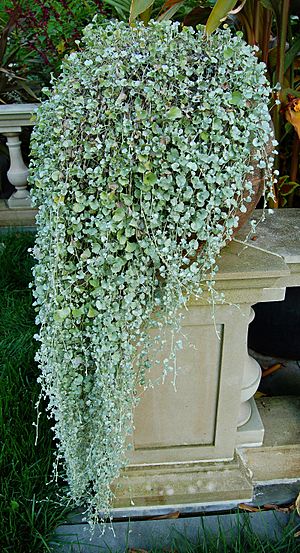Silver ponysfoot facts for kids
Quick facts for kids Silver ponysfoot |
|
|---|---|
 |
|
| Dichondra argentea 'Silver Falls' cultivar at Chanticleer Garden, Pennsylvania | |
| Scientific classification | |
| Genus: |
Dichondra
|
| Species: |
argentea
|
| Synonyms | |
|
Dichondra evolvulacea var. argentea (Willd.) Kuntze |
|
Dichondra argentea, also known as the silver ponysfoot or silver nickel vine, is a cool flowering plant. It belongs to the Convolvulaceae family, which also includes morning glories. This plant is known for its pretty silver-colored leaves and how it spreads out.
Contents
About Silver Ponysfoot
The silver ponysfoot is a type of plant called a perennial. This means it can live for more than two years. It grows by creeping along the ground. It usually stays about 4 inches (10 cm) tall. But its stems can grow very long, reaching up to 4 to 6 feet (1.2 to 1.8 meters) in length.
Where Silver Ponysfoot Grows
This plant is found in several different parts of the world. You can see it in places like New Mexico and Texas in the United States. It also grows in Mexico, Colombia, and Bolivia. Further south, it's found in northwest Argentina and southeast Brazil. Sadly, it used to grow in Arizona but is no longer found there.
How People Use Silver Ponysfoot
Even though it's a perennial, many people grow silver ponysfoot as an annual plant. This means they plant it new each year. It's very popular for hanging baskets because its long stems can trail down beautifully. It also makes a great ground cover. This means it spreads out to cover the soil, which can help keep weeds away.
Special Types of Silver Ponysfoot
One well-known type of silver ponysfoot is called 'Silver Falls'. This specific plant is very popular in gardens. It's loved for its bright, silvery leaves that look like a waterfall when they hang down. Gardeners often choose 'Silver Falls' for its unique look and easy care.

